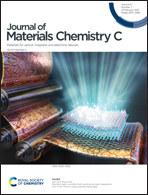Three new polymorphs of 1,8-diacetylpyrene: a material with packing-dependent luminescence properties and a testbed for crystal structure prediction†
Abstract
1,8-Diacetylpyrene (2′′AP) is an aromatic compound exhibiting aggregation-induced emission enhancement, with crystal structure predominantly stabilized by dispersive interactions. It was claimed to have a single stable crystal form uniquely defined by its chemistry. Here we demonstrate the existence of three more polymorphs with distinct optical properties, two of them obtained at high pressure (at circa 0.5 GPa). For all four polymorphs we present structures determined by single-crystal X-ray diffraction, and correlate DFT electronic structure calculations with Raman spectroscopy and UV-vis fluorescence experiments to elucidate impact of molecular arrangements on their optical properties. We also report Crystal Structure Prediction (CSP) study which indicates that such polymorphism could have been anticipated. We postulate that more widespread application of CSP in combination with electronic structure methods should be used to identify potential new functional materials even for already known moderate-size organic compounds.



 Please wait while we load your content...
Please wait while we load your content...